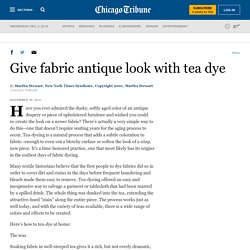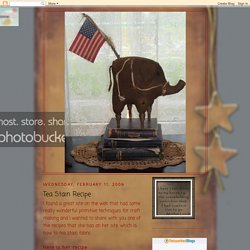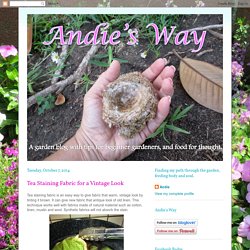

Give fabric antique look with tea dye - tribunedigital-chicagotribune. Have you ever admired the dusky, softly aged color of an antique drapery or piece of upholstered furniture and wished you could re-create the look on a newer fabric?

There's actually a very simple way to do this--one that doesn't require waiting years for the aging process to occur. Tea-dyeing is a natural process that adds a subtle coloration to fabric--enough to even out a blotchy surface or soften the look of a crisp, new piece. It's a time-honored practice, one that most likely has its origins in the earliest days of fabric dyeing. Many textile historians believe that the first people to dye fabrics did so in order to cover dirt and stains in the days before frequent laundering and bleach made them easy to remove.
Tea-dyeing offered an easy and inexpensive way to salvage a garment or tablecloth that had been marred by a spilled drink: The whole thing was dunked into the tea, extending the attractive-hued "stain" along the entire piece. Farm Wife Primitives: Tea Stain Recipe. I found a great site on the web that had some really wonderful primitive techniques for craft making and I wanted to share with you one of the recipes that she has on her site, which is how to tea stain fabric.

Here is her recipe: Tea Staining ~ Fabric Tea staining has been around a long time and was first used to hide stains on linens. It is one of the most popular ways to stain fabric and gives it a warm antique look. Different types of teas such a green tea, black tea, rasperry and herbel teas will give you different tints and tones on fabrics so don't be afraid to experiment a bit. Hibiscus tea will give you red tones while black teas give more of a soft brown or cream tone to the fabric. ~If your fabric is new be sure to wash it first to remove the sizing before dying ~I have found 4 cups of water and 4 single cup tea bags will dye one yard of fabric ~Bring the water to a boil and remove from heat add tea and let set for about 5 minutes until the liquid turns the desired color.
Andie's Way: Tea Staining Fabric for a Vintage Look. Tea staining fabric is an easy way to give fabric that warm, vintage look by tinting it brown.

It can give new fabric that antique look of old linen. This technique works well with fabrics made of natural material such as cotton, linen, muslin and wool. Synthetic fabrics will not absorb the stain. My mom used to tea stain fabrics she used in quilts to give them the aged look. She said her mother would use tea stain to camouflage small light stains on tablecloths. Our garden is suffering through the final weeks of summer. This fabric is my inspiration for the room. The birds are just so colorful which is perfect because this room needs to be cheery. This was the closest I could find to my perfect match but it is a bit too lime. The print is white instead of ivory and since these are pillows I will see up close everyday, the white would bother me against the ivory in the bird fabric.
Tea staining toned down the green and brought it to a place which is more aged. Watermark Tee. Hello U-Create readers!

I am so excited to be guest posting here today. It just so happens to be my first guest post and I'm still a little shocked that it's here at Ucreate, one of my favorite blogs! A little bit about me.. I'm from a little town called Keller, Texas. I'm a junior at Texas A&M University (whoop!). I'm working on my education degree and expect to be an elementary school teacher in just two short years. When I'm not busy studying for classes, I love to sew. I just started blogging in May and have already met all kinds of wonderful women, I hope you'll stop by and say hi too! Watermark Tee Tutorial What I love about this project is that it's completely customizable.
Materials: Elmer's Blue Gel Glue (it must be the blue gel, white won't work) Fabric Dye (RIT is my tried and true brand) A white cotton Tee, Tank, Dress etc. Tutorial: If you're unfamiliar with Batiking, it's a method of dyeing fabric in which you create a design with a dye- resist. Step 1: Prepare Step 2: Design.